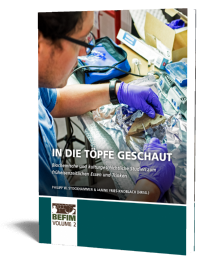Was tranken die frühen Kelten?
Bedeutungen und Funktionen mediterraner Importe im früheisenzeitlichen Mitteleuropa. Internationale Konferenz Kloster Weltenburg 28.04.-01.05.2017.
Edited by Philipp W. Stockhammer & Janine Fries-Knoblach | 2019

Was tranken die frühen Kelten?
Bedeutungen und Funktionen mediterraner Importe im früheisenzeitlichen Mitteleuropa. Internationale Konferenz Kloster Weltenburg 28.04.-01.05.2017.
Edited by Philipp W. Stockhammer & Janine Fries-Knoblach | 2019
Paperback ISBN: 9789088906145 | Hardback ISBN: 9789088906152 | Imprint: Sidestone Press | Format: 210x280mm | 338 pp. | BEFIM 1 | Language: Various | 37 illus. (bw) | 129 illus. (fc) | Keywords: Iron Age archaeology, Central Europe, Mediterranean, wine, import, imported pottery, cultural entanglement | download cover
Read online or downloaded 735 times
-
Digital & Online access
This is a full Open Access publication, click below to buy in print, browse, or download for free.
-
Buy via Sidestone (EU & UK)
-
Buy via our Distributors (WORLD)
For non-EU or UK destinations you can buy our books via our international distributors. Although prices may vary this will ensure speedy delivery and reduction in shipping costs or import tax. But you can also order with us directly via the module above.
UK international distributor
USA international distributor
-
Bookinfo
Paperback ISBN: 9789088906145 | Hardback ISBN: 9789088906152 | Imprint: Sidestone Press | Format: 210x280mm | 338 pp. | BEFIM 1 | Language: Various | 37 illus. (bw) | 129 illus. (fc) | Keywords: Iron Age archaeology, Central Europe, Mediterranean, wine, import, imported pottery, cultural entanglement | download cover
Read online or downloaded 735 times

We will plant a tree for each order containing a paperback or hardback book via OneTreePlanted.org.
Was die sogenannten „frühen Kelten” tranken, weckt seit über hundert Jahren das Interesse der Wissenschaft und der Öffentlichkeit. Funde mediterraner Importkeramik ließen Forscher_innen schon früh vermuten, dass den „Kelten“ vor allem an einer Nachahmung mediterraner Trinksitten gelegen war.
Die in Mitteleuropa gefundene Gelagekeramik griechischen Ursprungs und die mediterranen Transportamphoren sah man bis vor kurzem als Beleg für eben jene Übernahme griechischer Lebensstile auch nördlich der Alpen. An diesem Punkt setzte die Tagung an, deren Basis die Forschungen im Rahmen des vom Bundesministerium für Bildung und Forschung (BMBF) geförderten Verbundprojekts BEFIM (www.befim.gwi.uni-muenchen.de) darstellten. Es war das Ziel, innovative Ansätze aus den Geistes- und Naturwissenschaften zu verbinden und auf den archäologischen Befund gewinnbringend zu übertragen.
Zu diesem Zweck präsentierten im Rahmen der Konferenz Forscher_innen aus ganz unterschiedlichen Disziplinen ihre Forschungsergebnisse, sei es zur Interkulturalität, zur Keramik der „frühen Kelten“, zu naturwissenschaftlichen Analysen von Nahrungsrückständen oder Weinkonsum auch jenseits der Keltike.
Im Zentrum standen Fragen wie diese: Entfaltete der Kontakt mit fremden Trinksitten und -gefäßen ein transformatives Potential auch außerhalb einer vereinfachend als „Elite“ verstandenen Personengruppe? Wie schnell und in welchen Kontexten wurden exotische Getränke wie vor allem Wein angeeignet? Ging dies mit der Verwendung neuer Gefäßformen und damit vermutlich auch anderen Trinkpraktiken einher? Hatte die Akzeptanz ungewohnter Gelagesitten auch jenseits der „frühen Kelten“ kulturellen Wandel zur Folge? Wie können wir die mediterranen Getränke nachweisen? Was wurde zuvor auf welche Weise konsumiert? Was für Nahrungsmittel boten sich an, in (alkoholische) Getränke verwandelt zu werden und welche Herstellungstechniken fassen wir? Zeichnet sich auch der Austausch von Wissen zur Herstellung oder Würzung von Getränken im interkulturellen Dialog ab? Der Band richtet sich mit allgemeinen Einführungen, Überblicksartikeln und speziellen Beiträgen gleichermaßen an ein breites akademisches Publikum an Universitäten, Museen und in der Denkmalpflege wie an Studierende und interessierte Laien.
This is part 1 of the BEFIM project publication series, click here to see the other available volumes
English abstract
What the so-called “early Celts” used to drink has been a matter of debate amongst scientists and in the wider public for more than a century. Finds of Mediterranean imported pottery were the reason for scholars to suspect already at an early date that the “Celts” had aimed at imitating Mediterranean drinking habits. Until recently, these drinking vessels of Greek origin and Mediterranean transport amphorae were considered proof of exactly this adoption of Greek lifestyle even north of the Alps. This is the point, where our conference came into play, the basis of which is research conducted in the context of the joint research project BEFIM (www.befim.de).
We aim at connecting innovative approaches from both arts and sciences and at profitably transferring them to the archaeological evidence. To this purpose, academics from entirely different disciplines presented their research results at the conference – whether it be on interculturality, pottery of the early Celts, scientific analyses of food residues or wine consumption also beyond the Keltiké.
In the centre of interest there were questions such as these: Did the contact with foreign drinking customs and the associated vessels unfold transformative potential even beyond the group of persons we simplistically call the “elite”? How quickly and in which contexts were exotic drinks (such as wine in particular) appropriated? Was this accompanied by the use of new vessel types and thus perhaps also by different drinking habits? Did the acceptance of unusual banqueting customs result in cultural change beyond the early Celts? How can we prove the presence of these Mediterranean drinks? What used to be consumed in which way before their arrival? What types of food lent themselves to being transformed into (alcoholic) beverages at all and which techniques for producing drinks are reflected in the archaeological evidence? Is the exchange of knowledge on the production and seasoning of beverages recognisable in the intercultural dialogue?
This volume with its general introductions, overview articles, and specialised papers is directed at a broader academic public from universities, museums, and heritage preservation authorities on the one hand as well as students and interested non-specialists on the other hand.
This is part 1 of the BEFIM project publication series, click here to see the other available volumes
Vorwort – Philipp W. Stockhammer
Foreword – Philipp W. Stockhammer
Préface – Philipp W. Stockhammer
BEFIM: Neue Perspektiven auf die Kraft interkultureller Kontakte in der frühen Eisenzeit
Philipp W. Stockhammer
Gelagepraktiken als materiell-diskursive Apparate. Subjektivierung und Objektifizierung als Perspektiven auf die Aneignung von Trinksitten
Stefan Schreiber
Vessels from old excavations at the Heuneburg: new evidence for their functional interpretation
Birgit Schorer, Maxime Rageot, Angela Mötsch
Organic residues in pottery vessels from selected archaeological features of the Heuneburg: first results of a case study
Angela Mötsch, Maxime Rageot, Birgit Schorer
Studying vessel biographies from the Heuneburg: an experimental approach
Annelou van Gijn, Loe Jacobs, Nicholas Groat, Nicole de Koning, Dennis Braekmans, Annemieke Verbaas
Alkohol in der Eisenzeit. Anmerkungen aus botanischer und archäologischer Sicht
Manfred Rösch, Sabine Rieckhoff
Alcoholic drinks of prehistoric Europe: exploring the archaeobotanical evidence from the Aegean to Central Europe in the context of ERC project PlantCult
Soultana Maria Valamoti, Hans-Peter Stika
Grandes jarres et fosses allongées. La production de bière à l’âge du Fer en Champagne (France), entre le VIIe et le Ve siècle av. notre ère
Marion Saurel
Eat, drink, and be merry? Women and alcohol in ancient cultures of Eurasia
Janine Fries-Knoblach
Looking for ancient wine as a gift for the Prince of Lavau, dépt. Aube (5th cent. BC)
Nicolas Garnier, Bastien Dubuis
The life cycle of wine. Examples from the Bronze Age to the Middle Ages on the Italian Peninsula
Alessandra Pecci
Biomolekulararchäologische Annäherung an „Nordischen Punsch“
Patrick E. McGovern/Gretchen R. Hall/Armen Mirzoian
Expect the unexpected: implications of recent analyses of mortuary vessels for Early Iron Age social configurations and commensality in South-West Germany
Bettina Arnold
Gefäße in der früheisenzeitlichen Bilderwelt. Eine religionsarchäologische Betrachtung
Christoph Huth
Analyse fonctionnelle et faciès de consommation de la vaisselle céramique dans le Centre-Est de la France à la fin du premier et début du second âge du Fer (VIe-Ve siècle av. J.-C.)
David Bardel
Neue Forschungen am Mont-Lassois (Vix, Burgund): Ein späthallstattzeitliches Handwerksareal. Zur Kontextualisierung von Importwaren
Alexandra Winkler, Maxime Rageot
Contextualizing Greek pottery at Hallstatt sites
Justin St. P. Walsh
Alkohol als verkörperte materielle Kultur: Vergleichende kulturanthropologische Überlegungen zum Konsum von Alkohol
Michael Dietler
“Two casks in his house always, a cask of milk and a cask of ale”. Foodstuffs as currency in pre-monetary capitalist economic systems
Raimund Karl

Prof Dr. Philipp W. Stockhammer
Philipp W. Stockhammer is professor for prehistoric archaeology with a focus on the Eastern Mediterranean at Ludwig-Maximilians-University (LMU) Munich and co-director of Max Planck-Harvard Research Center for the Archaeoscience of the Ancient Mediterranean, Jena.

Dr. Janine Fries-Knoblach
Janine Fries-Knoblach studied prehistory, ancient history, classical and provincial-Roman archaology in Munich and Oxford and worked for heritage authorities and as a lecturer at the universities of Erlangen, Würzburg, and Freiburg. She spent much time editing and translating and was project coordinator of BEFIM at Ludwig-Maximilians-University (LMU) Munich from 2016-2018.
Abstract:
Was die sogenannten „frühen Kelten” tranken, weckt seit über hundert Jahren das Interesse der Wissenschaft und der Öffentlichkeit. Funde mediterraner Importkeramik ließen Forscher_innen schon früh vermuten, dass den „Kelten“ vor allem an einer Nachahmung mediterraner Trinksitten gelegen war.
Die in Mitteleuropa gefundene Gelagekeramik griechischen Ursprungs und die mediterranen Transportamphoren sah man bis vor kurzem als Beleg für eben jene Übernahme griechischer Lebensstile auch nördlich der Alpen. An diesem Punkt setzte die Tagung an, deren Basis die Forschungen im Rahmen des vom Bundesministerium für Bildung und Forschung (BMBF) geförderten Verbundprojekts BEFIM (www.befim.gwi.uni-muenchen.de) darstellten. Es war das Ziel, innovative Ansätze aus den Geistes- und Naturwissenschaften zu verbinden und auf den archäologischen Befund gewinnbringend zu übertragen.
Zu diesem Zweck präsentierten im Rahmen der Konferenz Forscher_innen aus ganz unterschiedlichen Disziplinen ihre Forschungsergebnisse, sei es zur Interkulturalität, zur Keramik der „frühen Kelten“, zu naturwissenschaftlichen Analysen von Nahrungsrückständen oder Weinkonsum auch jenseits der Keltike.
Im Zentrum standen Fragen wie diese: Entfaltete der Kontakt mit fremden Trinksitten und -gefäßen ein transformatives Potential auch außerhalb einer vereinfachend als „Elite“ verstandenen Personengruppe? Wie schnell und in welchen Kontexten wurden exotische Getränke wie vor allem Wein angeeignet? Ging dies mit der Verwendung neuer Gefäßformen und damit vermutlich auch anderen Trinkpraktiken einher? Hatte die Akzeptanz ungewohnter Gelagesitten auch jenseits der „frühen Kelten“ kulturellen Wandel zur Folge? Wie können wir die mediterranen Getränke nachweisen? Was wurde zuvor auf welche Weise konsumiert? Was für Nahrungsmittel boten sich an, in (alkoholische) Getränke verwandelt zu werden und welche Herstellungstechniken fassen wir? Zeichnet sich auch der Austausch von Wissen zur Herstellung oder Würzung von Getränken im interkulturellen Dialog ab? Der Band richtet sich mit allgemeinen Einführungen, Überblicksartikeln und speziellen Beiträgen gleichermaßen an ein breites akademisches Publikum an Universitäten, Museen und in der Denkmalpflege wie an Studierende und interessierte Laien.
This is part 1 of the BEFIM project publication series, click here to see the other available volumes
English abstract
What the so-called “early Celts” used to drink has been a matter of debate amongst scientists and in the wider public for more than a century. Finds of Mediterranean imported pottery were the reason for scholars to suspect already at an early date that the “Celts” had aimed at imitating Mediterranean drinking habits. Until recently, these drinking vessels of Greek origin and Mediterranean transport amphorae were considered proof of exactly this adoption of Greek lifestyle even north of the Alps. This is the point, where our conference came into play, the basis of which is research conducted in the context of the joint research project BEFIM (www.befim.de).
We aim at connecting innovative approaches from both arts and sciences and at profitably transferring them to the archaeological evidence. To this purpose, academics from entirely different disciplines presented their research results at the conference – whether it be on interculturality, pottery of the early Celts, scientific analyses of food residues or wine consumption also beyond the Keltiké.
In the centre of interest there were questions such as these: Did the contact with foreign drinking customs and the associated vessels unfold transformative potential even beyond the group of persons we simplistically call the “elite”? How quickly and in which contexts were exotic drinks (such as wine in particular) appropriated? Was this accompanied by the use of new vessel types and thus perhaps also by different drinking habits? Did the acceptance of unusual banqueting customs result in cultural change beyond the early Celts? How can we prove the presence of these Mediterranean drinks? What used to be consumed in which way before their arrival? What types of food lent themselves to being transformed into (alcoholic) beverages at all and which techniques for producing drinks are reflected in the archaeological evidence? Is the exchange of knowledge on the production and seasoning of beverages recognisable in the intercultural dialogue?
This volume with its general introductions, overview articles, and specialised papers is directed at a broader academic public from universities, museums, and heritage preservation authorities on the one hand as well as students and interested non-specialists on the other hand.
This is part 1 of the BEFIM project publication series, click here to see the other available volumes
Contents
Vorwort – Philipp W. Stockhammer
Foreword – Philipp W. Stockhammer
Préface – Philipp W. Stockhammer
BEFIM: Neue Perspektiven auf die Kraft interkultureller Kontakte in der frühen Eisenzeit
Philipp W. Stockhammer
Gelagepraktiken als materiell-diskursive Apparate. Subjektivierung und Objektifizierung als Perspektiven auf die Aneignung von Trinksitten
Stefan Schreiber
Vessels from old excavations at the Heuneburg: new evidence for their functional interpretation
Birgit Schorer, Maxime Rageot, Angela Mötsch
Organic residues in pottery vessels from selected archaeological features of the Heuneburg: first results of a case study
Angela Mötsch, Maxime Rageot, Birgit Schorer
Studying vessel biographies from the Heuneburg: an experimental approach
Annelou van Gijn, Loe Jacobs, Nicholas Groat, Nicole de Koning, Dennis Braekmans, Annemieke Verbaas
Alkohol in der Eisenzeit. Anmerkungen aus botanischer und archäologischer Sicht
Manfred Rösch, Sabine Rieckhoff
Alcoholic drinks of prehistoric Europe: exploring the archaeobotanical evidence from the Aegean to Central Europe in the context of ERC project PlantCult
Soultana Maria Valamoti, Hans-Peter Stika
Grandes jarres et fosses allongées. La production de bière à l’âge du Fer en Champagne (France), entre le VIIe et le Ve siècle av. notre ère
Marion Saurel
Eat, drink, and be merry? Women and alcohol in ancient cultures of Eurasia
Janine Fries-Knoblach
Looking for ancient wine as a gift for the Prince of Lavau, dépt. Aube (5th cent. BC)
Nicolas Garnier, Bastien Dubuis
The life cycle of wine. Examples from the Bronze Age to the Middle Ages on the Italian Peninsula
Alessandra Pecci
Biomolekulararchäologische Annäherung an „Nordischen Punsch“
Patrick E. McGovern/Gretchen R. Hall/Armen Mirzoian
Expect the unexpected: implications of recent analyses of mortuary vessels for Early Iron Age social configurations and commensality in South-West Germany
Bettina Arnold
Gefäße in der früheisenzeitlichen Bilderwelt. Eine religionsarchäologische Betrachtung
Christoph Huth
Analyse fonctionnelle et faciès de consommation de la vaisselle céramique dans le Centre-Est de la France à la fin du premier et début du second âge du Fer (VIe-Ve siècle av. J.-C.)
David Bardel
Neue Forschungen am Mont-Lassois (Vix, Burgund): Ein späthallstattzeitliches Handwerksareal. Zur Kontextualisierung von Importwaren
Alexandra Winkler, Maxime Rageot
Contextualizing Greek pottery at Hallstatt sites
Justin St. P. Walsh
Alkohol als verkörperte materielle Kultur: Vergleichende kulturanthropologische Überlegungen zum Konsum von Alkohol
Michael Dietler
“Two casks in his house always, a cask of milk and a cask of ale”. Foodstuffs as currency in pre-monetary capitalist economic systems
Raimund Karl

Prof Dr. Philipp W. Stockhammer
Philipp W. Stockhammer is professor for prehistoric archaeology with a focus on the Eastern Mediterranean at Ludwig-Maximilians-University (LMU) Munich and co-director of Max Planck-Harvard Research Center for the Archaeoscience of the Ancient Mediterranean, Jena.

Dr. Janine Fries-Knoblach
Janine Fries-Knoblach studied prehistory, ancient history, classical and provincial-Roman archaology in Munich and Oxford and worked for heritage authorities and as a lecturer at the universities of Erlangen, Würzburg, and Freiburg. She spent much time editing and translating and was project coordinator of BEFIM at Ludwig-Maximilians-University (LMU) Munich from 2016-2018.
-
Digital & Online access
This is a full Open Access publication, click below to buy in print, browse, or download for free.
-
Buy via Sidestone (EU & UK)
-
Buy via our Distributors (WORLD)
For non-EU or UK destinations you can buy our books via our international distributors. Although prices may vary this will ensure speedy delivery and reduction in shipping costs or import tax. But you can also order with us directly via the module above.
UK international distributor
USA international distributor
- Browse all books by subject
-
Search all books

We will plant a tree for each order containing a paperback or hardback book via OneTreePlanted.org.
You might also like:
© 2025 Sidestone Press KvK nr. 28114891 Privacy policy Sidestone Newsletter Terms and Conditions (Dutch)








